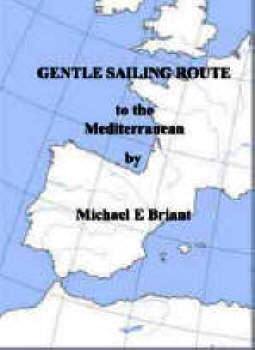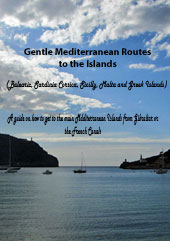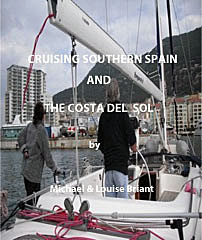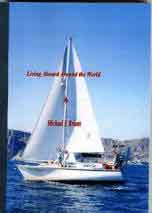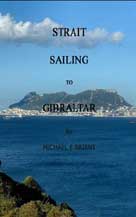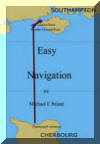
The following article was published in the 1982 July edition of
PRACTICAL BOAT OWNER.
My first foray into writing about boats and the sea!
Gamine was a 25 ft almost new Jaguar yacht purchased new at the London Boat Show and launched some 3 months previously. She had a 5 HP outboard motor, seat toilet and a table which was why my wife preferred her to the previous boat I had owned, a very pretty little '22ft Galion' - Mignonne.
|
FIRST TIME WITH VHF MICHAEL BRIANT steers into trouble . ..
AT NINE o'clock I was at Tower Hill, London, taking the test to become a restricted VHF radio operator and by mid-day Monique and I were motoring down to the Hamble with a brand new Sealine radio telephone, and an operator's licence amongst our luggage. We got on board our Jaguar 25 Gamine and sailed over a foul tide down to Yarmouth, Isle of Wight, ready to catch the morning tide for the Needles and Cherbourg. Even Monique, who had not sailed for three years, since returning from France in a Force seven, was feeling confident. Off Newtown Creek, I put the Auto-helm on and left Monique on watch whilst I installed the radio telephone. (The aerial had been fitted to the masthead in the winter.)
By the time we were entering Yarmouth the
new amazing world of radio communications at sea had opened up. Niton
Radio, link calls, TR's (Traffic Routing Reports), intership messages, a
whole new aspect of sailing. The morning forecast was Northerly 4 to 5;
locally 6.1 felt that we were set for a fast passage. Monique was very apprehensive about it, with memories of her last, rather
frightening experience. But I explained that with the wind behind us
all the way, we were unlikely to be buffeted about too much and in any
case we might very well not find the locally six.As
we rounded the Needles I set the Autohelm to steer us due south and I
picked up the handset of my new radio telephone, for the first time and
made my TR to Solent Coastguard. At the end of the exchange they wished
'good sailing'. I noted the time and position in the log, and on the
chart, and then made coffee and continued to try to persuade Monique
that there was nothing to worry about. I pointed out the other sails on
the horizon heading for the French coast or Channel Islands. I was not
the only fool . . .
The second time I picked up the microphone of the Sealine was to chat with a large Fisher, Liberator, that was coming up from astern. They were having a rather bumpy passage, one of the crew was seasick and half an hour later they called and told me they were going about to run into Poole. We said 'Goodbye' and Monique said that I was a fool. I patiently explained that we were making just over six knots and that we would be in Cherbourg by 21.00 hours. I felt that if we turned and went into Poole or Weymouth, Monique would, have, had all her worst fears confirmed that sailing was a highly dangerous business, and would refuse ever to go near a boat again.
The 13.55 forecast was still NE 4-5, locally 6. I put a reef in the main and went below to make some lunch and tried to console Monique. The forecast was good, the wind was set fair for France and we were making record time. Monique was still not convinced. At 16.001 went below to write up the log and plot our DR. I got the Seafïx out and produced quite a small cocked hat, but the centre was seven miles east my DR.
I had just finished plotting when there was a crash in the stern and I saw the Autohelm go flying across the cockpit, the tiller leapt in the air and disappeared over the stern and the jib started to flap.
In a second I was in the cockpit recovering the rudder from the water and blessing Frank Hudson who had suggested that a transom-hung rudder should also have a stout length of line on it connecting it to the boat. I pulled the rudder on board to discover that the blade had broken across the line of the stock. I couldn't believe it. Monique was not too impressed either.
A jury rudder was the answer and I lashed an oar to the stock. I then found it impossible to locale the pintle — I just didn't have the strength. For half an hour I struggled with my head over the stem until I heard the radio say:
‘SECURITAY, SECURITAY, NORTH EASTERLY GALE EIGHT FOR SEA AREA DOVER IMMINENT'
I couldn't believe my ears. North easterly eight meant it could come my way. The French coast as a lee shore, in a force eight, on spring tides, in a rudderless boat, was a worrying proposition. I picked up the microphone for the third time ever.
‘PAN-PAN PAN-PAN PAN-PAN. THIS IS GAMINE, GAMINE. GAMINE, ALL STATIONS, ALL STATIONS, etc.’
At home my Children had sent me up rotten for practising for the radio telephone test . . Cherbourg radio replied at once. I explained my problems and they asked me to wait. A British yacht came through and asked me to repeat my position. He went and plotted my DR on his chart. We were having trouble hearing each other and gradually we lost contact so I think he must have been ahead of me.
I could see three sails on the horizon. There was no way of contacting the other yachts, short of sending up flares and the situation certainly didn't justify that. It was frustrating to see the sails on the horizon but there was nothing to do about it.
I went to experiment with Gamine's sails. I stowed the main and discovered that I could make her sail more or less south under the working jib. My DR position was 18 miles due north of Cherbourg unless I believed the radio fix. There coming up from the south was a large ship heading north east. 1 called her first:
"SHIP HEADING NORTH EAST WITH YACHT ON HER PORT BOW’
No reply.
Then on her stern I saw the company name and called
‘FREIGHTLINER….’
No reply. Then on her stern in small letters I saw her name PURBECK. The radio operator replied to my call and relayed my exact position to Cherbourg radio and I laid it off on the chart. I was pleased to note that my DR was only l 1/2 miles out
Cherbourg Radio came back with the information that the French Navy ship ‘Le Bihan’ was heading for my position and told them I was heading south at about three knots. The wind force was starting to increase considerably and Gamine was beginning to be difficult to control, so I took down the working jib and put up the storm jib, which was a great improvement. I took the opportunity to get Monique into a safety harness and life-jacket. I put on a lifejacket as well in case I had to unclip my safety harness from Gamine.
We were still heading south through the French shipping lane when Le Bihan called to ask if I could see her. I searched the horizon and other than the sails of two yachts I could see only a couple of ships heading east from the Casquets.
Le Bihan confirmed that there was another ship just ahead of them and that she had a square structure on her stern. I sent them a series of hearings on the second ship. .. I looked over my shoulder and there on the horizon was the unmistakable silhouette of a warship. I called Le Bihan and gave them the correct bearing and waited as they circled in order to provide Gamine with some sort of lee from the brisk Force seven now blowing. They lowered the Zodiac into the water and the frogman struggled to start the motor, which had already been swamped a couple of times. Le Bihan drifted down to Gamine and the venturi effect caused Gamine to come up into the wind to try to ram the warship. The Captain of Le Bihan sent full ahead both, and I rushed up to the pulpit to fend off and came for moment on the top of a wave, face to face with a sailor on the deck of the frigate as he manoeuvred a big wicker fender. The stern of Le Bihan screwed round away from me and disaster was averted by some splendid French seamanship. .
With some difficulty the Zodiac crew of frogmen motored through the turbulent sea and came alongside Gamine. The leader came on board and asked me to sign a "No cure No pay" document. He explained it was only to cover their own insurance as it was now blowing a full gale and was pitch dark — Monique said 'Just sign it'
I signed.
The Zodiac crew promptly left. An hour or so later the three man crew returned with a large coil of rope to make a harness for the tow line. The leader of the frogmen was desperately sick and cursed British yachts. Monique agreed with him completely and joined him in disparaging comments about the entire situation. The junior frogman did a splendid job in appalling conditions fixing a strop all round the hull and running lines under the hull either side of the keel to form a secure towing point.
Le Bihan closed us again and shot a line across to which the tow rope was attached. In spite of being very sick the frogman in charge checked every point of the strop and the tow. Le Bihan with Gamine astern headed for Cherbourg..
At about 01.00 after an hour of towing the frogmen were very cold and were ordered to return to their ship. Monique wanted to go with them as she was a bit ‘off ‘Gamine but the Captain of Le Bihan said that a transfer was too dangerous. Not surprising when you consider that I would lose sight of the frigate altogether in the troughs, I spent the next hour in the cockpit behind the spray-hood and then went below to make coffee and to put food inside me. Le Bihan had been towing us at about five knots and we were now about eight or nine miles north of the Alderney Race.
I felt the seed increase and Gamine started to slam very badly. We seemed to fall right off one wave. I radioed the French warship and they slowed down the one knot they had increased speed. I stayed in the cabin, wedged in, listening to the sounds of the tow. It was 03.00 and Monique had got herself into a bunk, and with my foot in her back she was trying to sleep. In spite of the gale, Gamine was behaving well and I felt very secure. Channel 16 was alive with distress calls. Jersey radio was handling two boats in trouble. Alderney was instilling confidence in someone else and Guernsey was also dealing with a fishing boat in need of help. Another small yacht was being towed in by the French from the Casquets and a lost catamaran was beîng talked into Cherbourg by a French Auxiliary Coastguard.
Later that morn-ng I heard Jersey coastguard remark a Guernsey coastguard: "It's the start of the silly season". I felt foolish…. Then the tow parted! I couldn't believe it! I rushed into the cockpit in time to see le Bihan vanish to port behind a wave. 1 called on the VHF and she started to come about in order to find us, The seas off the north coast were very big and for quite long periods I couldn't see the lights of the frigate and she couldn't see me. The situation was resolved by holding up an automatic flashing lifebuoy light as high as I could.
Le Bihan was worried that we were very close to Alderney Race on a west going stream and as it would take a considerable time to launch the Zodiac and get another tow across, they asked if I would receive the rocket line. My only problem was that the towing harness went across the safety lines – jackstays - onto which I clip my harness. It took some time to work my way to the bows having to unclip and clip on at every stanchion. It was the first time I had ever seen the tops of waves just breaking off and falling down the front, but Gamine still seemed to ride the white water very well.
As I clung to the mast, I watched the marksman with the rocket gun prepare to fire. I knew they wanted me to get out of sight, but the noise of the wind and Gamine being tossed about by the sea made it imperative I should watch for the moment of firing. With amazing accuracy the nylon line fell across the forestay and I dived forward to grab it before it slid into the water. I jammed myself into the pulpit. I was also surprised how heavy the line was as I pulled it in. I was surprised how long it was. I was surprised when up out of the water came the wooden bullet. In my stupid haste I had pulled in the wrong end!
I started to heave the other end. It was almost impossible to move. I realised that seeing me pull the nylon rocket line, Le Bihan had paid out the towrope which was now in the water. I made my way back to the mast and took a couple of turns of nylon line round the halyard winch. It pulled tight and then parted. I could see the crew looking under the stern of Le Bihan and at that moment I realised that the tow rope had drifted under the stern of Le Bihan and fouled her prop.
And that was my fault too.
I made my way back to the cockpit and called her up on VHF. She sounded pretty disconsolate and I heard her requesting Cherbourg to send out a tug. Le Bihan then asked me how much anchor chain I had and at that moment, for the very first time, I really felt quite worried. My 15 fathoms of chain and 15 fathoms of warp were not going to hold Gamine in a full gale in those seas even if we found shallow enough water before bumping into land!
A perky Le Bihan came back on the VHF — their prop was clear and they told me to stand by to receive another tow line. I hid behind the mast again whilst the very talented marksman tried to put the line across my forestay, for the third time that night. The frigate held station on Gamine, in all that wind, close enough for me to pull the towing warp in, without letting the venturi effect take over.
Tow was resumed into Cherbourg and as dawn came up the Navy tug joined us. I felt I had been punished once by the tow breaking, for leaving the cockpit, so I huddled up in a corner behind the spray hood, keeping an occasional watch on the tow. I think the tug and Le Bihan were rolling more than Gamine.
A shore official came on board Gamine as soon as we were tied to a buoy in Cherbourg inner harbour.
He took various statements off me and
made me sign another copy of the salvage document. He said the price of
the tow was £13,000!! He then took me on board Le Bihan where I was able
to thank the Captain for his assistance.
For the £13,000 I wasn't sure whether to laugh or cry. Still Monique cooked a wonderful breakfast and m the quiet of Cherbourg Marina I crept into my bunk and dreamed of pound notes jumping over waves. • NOTE: In the end the French Navy settled with my insurance company for £l,300 for salvage/tow. Other than the broken rudder. the only damage to Gamine was a torn storm jib and a broken Walker log. The Sealine VHF kept me in touch with Cherbourg Radio and Le Bihan perfectly. Without VHF available the situation could have become very dangerous. ©copyright Michael E Briant 1982 + 2006 La Rochelle France Published in Practical Boat Owner JULY 1982
|
|
I am pleased to say this web site is who have been kind, helpful and understanding. I really recommend them |



